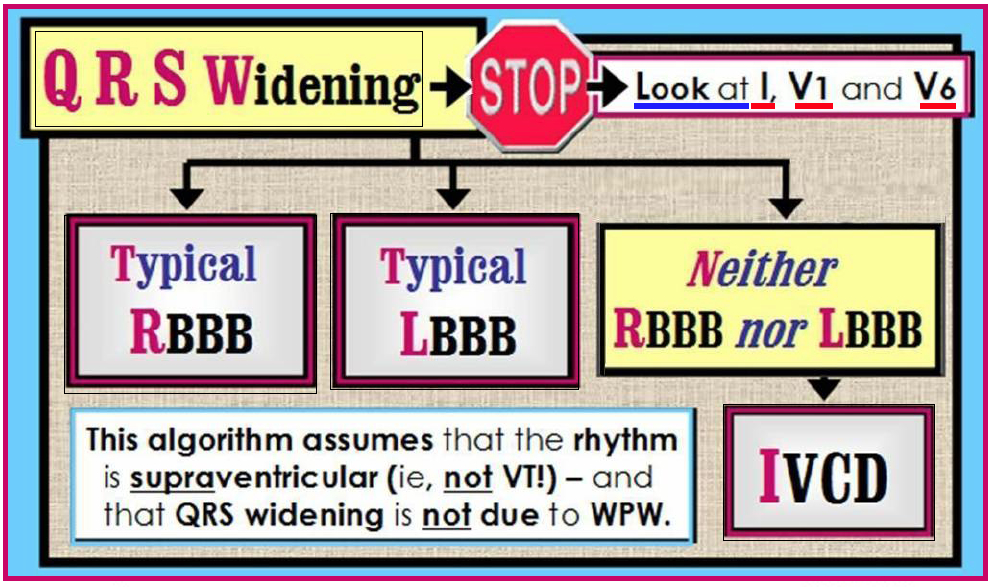

There was no significant difference in mortality between the LBBB and rLBBB groups. LV EF significantly improved in the LBBB (p < 0.001), rLBBB (p = 0.002), and pLBBB (p < 0.001) groups, but the RBBB and IVCD groups showed no improvement. Standard CRT indications: LBBB or interventricular conduction delay (IVCD) or LBBB. After CRT, QRS duration was significantly reduced in the LBBB (p < 0.001), pLBBB (p < 0.001), rLBBB (p < 0.001), RBBB (p = 0.04), and IVCD groups (p = 0.03). LVEF: Left ventricular ejection fraction. Mean age at implant was 67.5 years (standard deviation = 10.6), mean left ventricular ejection fraction (LV EF) was 25.7% (SD = 7.9%), and mean QRS duration was 158.4 ms (SD = 32 ms). Prior to CRT, 52.2% of patients had true left bundle branch block (LBBB), 19.1% a pacing-induced LBBB (pLBBB), 11.2% a rLBBB, 0.8% a right bundle branch block (RBBB), and 16.5% had a nonspecific intraventricular conduction delay (IVCD) electrocardiogram pattern. ICD-10-CM I44.7 is grouped within Diagnostic Related Group(s) (MS-DRG v39.A total of 690 CRT implants were identified during the study period. Right chest lead v1 may or may not show an initial r wave, but the latter should be present in lead v2. In hearts with an electrical (and anatomic) vertical position a small q wave may be seen in avl in the absence of mi. A wide r wave with a notch on its top (plateau) is seen in these leads. The diagnostic criteria consist of prolongation of the qrs complexes (over 0.11s) with neither a q wave nor an s wave in lead v1 and in the properly placed v6. This conduction disturbance is characterized by wide (greater than 0.11s) qrs complexes. Conduction in RBBB: With a blockage in the right bundle branch (red), the left ventricle is excited in time (purple), while the excitation of the right ventricle takes a detour via the left bundle branch (blue arrows). Methods: We assessed 542 consecutive patients presenting for the new implantation of a CRT device. An impairment of transmission of the cardiac electrical impulse along the fibers of the left main bundle branch, or both the left anterior fascicle and left posterior fascicle. All myocardial segments are excited almost simultaneously (purple staining). Little is known about the response to CRT in patients with right bundle branch block (RBBB) or non-specific intraventricular conduction delay (IVCD) compared with traditionally studied patients with left bundle branch block (LBBB).In bundle branch block, only one of the ventricles is directly caused to contract by the. with R-IVCD constitute a subgroup of patients with a long Q-LV interval. In the presence of a bundle branch block, the QRS is wider than its normal value of. of left bundle branch block with the ST-elevation to S-wave ratio in a. In hearts with an electrical (and anatomic) vertical position a small q wave may be seen in avl in the absence of mi. The determination that a bundle branch block (often referred to as BBB) exists is made by reviewing a patient’s EKG. Other IVCDs had no significant impact on prognosis. In a population study with long-term follow-up, NSIVCD and Minnesota definition of LBBB were independently associated with CV mortality. A wide r wave with a notch on its top ("plateau") is seen in these leads. The prognostic impact of LBBB and NSIVCD was affected by the definition of the conduction disorder. The diagnostic criteria consist of prolongation of the qrs complexes (over 0.11s) with neither a q wave nor an s wave in lead v1 and in the "properly placed" v6. An impairment of transmission of the cardiac electrical impulse along the fibers of the left main bundle branch, or both the left anterior fascicle and left posterior fascicle.A cardiac rhythm characterized by qrs duration 120 ms or longer, delayed onset of intrinsicoid deflection in 1, v5, and v6 >60 ms, broad and notched or slurred r waves in i, avl, v5, and v6, rs or qs complexes in right precordial leads, st-segment and t waves in opposite polarity to the major qrs deflection.transient cerebral ischemic attacks and related syndromes ( G45.-).systemic connective tissue disorders ( M30-M36).

symptoms, signs and abnormal clinical and laboratory findings, not elsewhere classified ( R00- R94).injury, poisoning and certain other consequences of external causes ( S00-T88).endocrine, nutritional and metabolic diseases ( E00- E88).congenital malformations, deformations, and chromosomal abnormalities ( Q00-Q99).



 0 kommentar(er)
0 kommentar(er)
